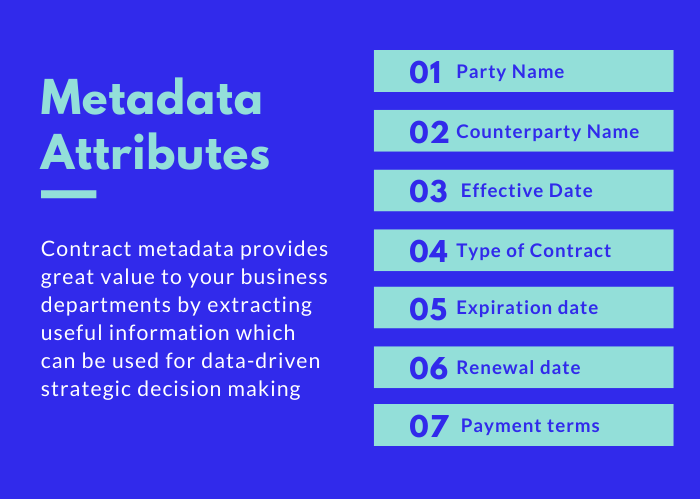Extracting contract metadata – the structured data hidden inside legal agreements is often more challenging than it seems. Traditional manual methods require opening each contract, scanning through the document, and copying key fields into tools like Excel. This makes contract metadata extraction slow, expensive, and prone to error.
Today, organizations need faster, more accurate ways to extract metadata from contracts to improve compliance, reporting, and decision-making.
What Is Contract Metadata?
Contract metadata refers to structured attributes and values extracted from contracts that help organize, track, and analyze agreements. These metadata elements vary by contract type but typically include:
Below are the most common metadata attributes that are generally extracted along with the other contract-specific attributes:

Capturing these fields accurately is essential for contract lifecycle management (CLM), compliance, and risk management.
Why Manual Metadata Extraction Is Inefficient
Time studies show that extracting just one attribute manually takes around 2 minutes. With an average of 30 metadata elements per contract, that’s about 1 hour per document.
Consider this:
-
10,000 contracts × 30 metadata fields = 5,000 person-hours
-
Include tasks like quality control, OCR scanning, document organization, etc., and the effort jumps to 8,000+ person-hours
If a team of 5 people works 7 hours a day, 19 days a month, this task alone would take them approximately 1 year.
Strategies of Contract Metadata Extraction
There are three common approaches to extracting metadata:
1. Fully Manual Extraction
- Involves legal professionals or contract managers manually reviewing and abstracting data.
- Cons: High risk of human error, inconsistencies across team members, slow process.
2. Fully Automated Extraction
- Uses contract analysis or AI-driven software.
- Cons: Legal language is nuanced; software may miss context or misinterpret clauses. Requires installation, training, maintenance, and ongoing quality control.
3. Hybrid Extraction (Technology-Enabled Service)
- Combines automation with human review.
- Software extracts metadata, and a trained team validates the data.
- Pros: High accuracy, scalability, and faster turnaround.
- Bonus: One vendor provides both tech and service—”one throat to choke.”
Choosing the Right Approach
While automation sounds attractive, the quality and accuracy of extracted metadata can make or break your contract analytics. A hybrid solution provides the best of both worlds, speed from automation and accuracy from human expertise.
Before embarking on a metadata extraction project, evaluate:
- Volume and complexity of your contracts
- Required turnaround time
- Regulatory or compliance risks
- Availability of internal resources
📊 Market Insight
The OCR market is projected to hit $32.9B by 2030 , and CLM software is valued at $1.74B in 2024 with strong growth ahead.These numbers highlight how much businesses are prioritizing contract data automation and underscore why efficient metadata extraction strategies are essential today.
Final Thoughts
Extracting metadata from contracts is a strategic task that can streamline contract management, improve visibility, and support business growth. A hybrid approach offers the most reliable, scalable, and cost-effective method.
Looking to extract metadata from contracts without the hassle? Reach out to us to learn how our technology-enabled services can help.
